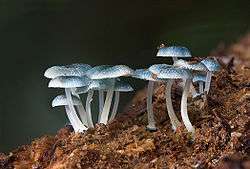Saprophagy
Saprophages are organisms that obtain nutrients by consuming decomposing dead plant or animal biomass.[1] They are distinguished from detritivores in that saprophages are sessile consumers while detritivore are mobile. Typical saprophagic animals include sedentary polychaetes such as amphitrites (Amphitritinae, worms of the family Terebellidae) and other terebellids.

The eating of wood, whether live or dead, is known as xylophagy. The activity of animals feeding only on dead wood is called sapro-xylophagy and those animals, sapro-xylophagous.
Ecology
In food webs, saprophages generally play the roles of decomposers. There are two main branches of saprophges, broken down by nutrient source. There are necrophages which consume dead animal biomass, and thanatophages which consume dead plant biomass.
See also
- Detritivore
- Decomposer
- Saprotrophic nutrition
- Consumer-resource systems
References
- Getz, Wayne M. (February 2011). "Biomass transformation webs provide a unified approach to consumer-resource modelling". Ecology Letters. 14 (2): 113–124. doi:10.1111/j.1461-0248.2010.01566.x. PMC 3032891. PMID 21199247.
